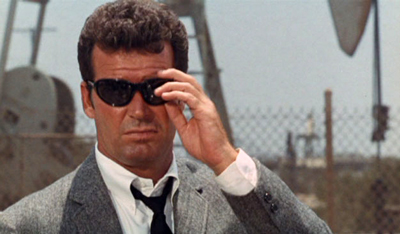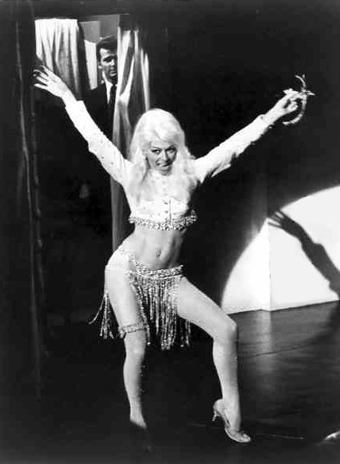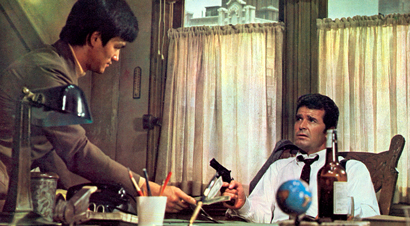
 |
|
|
|
When published film criticism turned its attention to film genres in the early 1970s, special focus was put on the new breed of film detectives that seemed bent on updating the 1940s heyday of trench coats and offices with a bottle in the file cabinet. The English critics loved Robert Altman's The Long Goodbye for its revisionist insouciance (nice ring to that) but most of the other latter-day Chandler knockoffs got the cold shoulder. A prime picture to pick on was 1969's Marlowe, a moderately budgeted rethink of Raymond Chandler's The Little Sister starring James Garner. Ex- Maverick Garner wasn't a film critic's idea of hip, having come through a decade of movies without really attaining superstar status or cult prominence. Garner's natural way with a deadpan dialogue line still seemed more small screen-ish than cutting edge. The general consensus was that he was posing as Chandler's Philip Marlowe, as opposed to playing him. If that snobbery wasn't enough there's director Paul Bogart, previously a prolific television director. When Bogart made good movies like Garner's Skin Game, all the attention went to the screenwriter, or the star. 
With all of that set aside, Marlowe can shine for what it is: an unostentatious Chandler adaptation with good performances and good dialogue. The smart patter comes courtesy of Stirling Silliphant, who follows the form of the gumshoe epic without sending up the subgenre or resorting to hardboiled extremes, as in the conveniently titled, amusing Gumshoe. With enough years between us and his Jim Rockford character, James Garner makes a capable Philip Marlowe, even if he's perhaps a bit too good-looking and rugged for the part. Although Philip Marlowe looks perfectly capable of dropping any of the goons he comes up against, he remains a passive sleuth. Erratic, naíve Kansas girl Orfamay Quest (Sharon Farrell) hires Philip Marlowe (Garner) to find her runaway brother Orrin (Roger Newman). Garner returns Orfamay's retainer when he discovers that Orrin is involved in a dirty picture blackmail scheme against movie star Mavis Wald (Gayle Hunnicutt), and that people are turning up with ice picks stuck in their necks -- a chatty hotel manager and a sleazy con-man surely in on the blackmail as well (Jackie Coogan). Worse, Mavis is being protected by the man with her in the photos, transplanted Brooklyn mob killer Sonny Steelgrave (H.M. Wynant). Mavis' friend (and striptease artiste) Dolores Gonzáles (Rita Moreno) runs interference for the movie star, while Steelgrave sends kung-fu tough guy Winslow Wong (Bruce Lee) to buy Marlowe off, or kill him. Marlowe dodges the attention of Police Lieutenant Christy French (Carroll O'Connor) and convinces Mavis Wald's talent agent Mr. Crowell (William Daniels) to hire him to protect the star. But who really needs protection, and from whom? 
Marlowe gets off to a bad start, blowing its first scene by draping a bunch of unconvincing MGM hippies on the doorstep of a Venice ("Bay Cities", to Chandler fans) flophouse. Modern West L.A. residents know that that all that beach real estate has since been grossly overdeveloped; the days when you could linger among real Venice Bohemians has long passed. From that point forward everything clicks in a typically twisty Chandler plot that forces Marlowe to deal with at least eight characters that refuse to tell him the truth. People blackmail each other and go crazy in their sex obsessions, and several of them end up in mincemeat. The critics are right in that Garner's Marlowe, who seems a fan of old Greta Garbo movies, should see a number of Chandler's clichés coming. His apartment and office are thoroughly trashed, right on cue. Never, never enter a doctor's private clinic in a Chandler story, as you'll invariably be tricked into taking some hallucinogenic drug. 1 Marlowe somehow manages to be on-site at every ice pick killing. He's a regular dead body magnet. Garner's Marlowe is our conduit to a gallery of fine characterizations, and the credit for blending the performances needs to be handed to director Bogart. Gayle Hunnicutt is properly aloof as the compromised star, while Sharon Farrell makes the grating, scattered Orfamay both funny and interesting. Corrine Camacho earns some respect, if not enough scenes, as Marlowe's girlfriend. The femme standout is of course Rita Moreno, who is by turns provocative and intelligent without giving away her character's key role: "The streets are paved with forgotten husbands!" Moreno also performs one of the classiest stripteases of any star performer in American films, really heating up the final scene. The movie only got an "M" (later PG) rating, but to me this scene says 'nudity in a sexual context' in the best possible way. 2 In contrast to the grotesques, perverts and sadists of the '40s Chandler stories, the supporting characters of this Marlowe are unusually sympathetic. The oily Jackie Coogan, with a clue taped to his toupeé is just a lowlife chiseler trying to get along, while the cops are less barking dogs than nice guys. Even the police Sgt. played by tough guy Kenneth Tobey is likeable, especially after an emotion-charged argument ends up with Carroll O'Connor accidentally socking him in the jaw, instead of Marlowe. It plays perfectly. Sharon Farrell's vulgar, treacherous Orfamay Quest has her moments -- and it's fall-down funny to see her ejected from Marlowe's apartment: "Kansas is that way." 
Marlowe's Bruce Lee connection sent kung fu fans scrambling to see it in the early '70s, only to discover that their martial arts superstar is only in two scenes and is made the butt of a joke (Marlowe taunts Winslow Wong as gay, to get him off balance. Lee's high kicks are impressive but the necessary direction ("jump around a lot, but never hit Garner") makes the fighting technique seem ineffective. At this time known mainly from the Green Hornet TV show, Lee was clearly used to give the picture some "fun" action. Although his dialogue is brief, this is probably the best bit of acting in Bruce Lee's brief career. Incidentally, Marlowe has been given a fussy beauty college instructor for an office neighbor, but the guy is apparently not gay -- when Marlowe notes his black leather pants, the guy says that they drive the chicks wild. I suppose the next stop is Shampoo. William H. Daniels' cinematography makes the women look attractive (even Hunnicutt in her 'big hair' hairdos) and does a good job lighting some of the interior sets with the fake backdrops. The movie doesn't shovel on the Los Angeles ambiance, but we do get a glimpse of the Sunset Strip when Marlowe picks up his beat-up convertible. By contrast, the yellow XKE driven by Wald and Gonzáles has "motorized sex" written all over it. Those studio cheapskates use the main MGM office building as the business address of a large talent agency. I've always liked Marlowe, an unpretentious and entertaining detective mystery from one of Chandler's better books. I was seeing a lot of what was released in 1969 and I'm not sure that this show received full distribution -- I don't remember it playing out in the sticks. The trailer tag line "Welcome to Marlowe Country!" seems to be admitting that there's so little interest in the story that it can be sold with a reference to Marlboro cigarettes ... with the same font used in the tobacco ads. All it takes for a good picture like this to take off is a distributor that doesn't give up before it starts. 
The Remastered Edition of Warner Archive Collection DVD-R of Marlowe looks quite good, with a bright and colorful enhanced widescreen image and a strong soundtrack that gives free rein to the music score by Peter Matz. The disc comes with a copy of the film's so-so original trailer. I've always thought that Marlowe would have done better with a slicker ad campaign, under the original title The Little Sister, but I guess vintage private eyes were considered corny in 1969. And it's too bad that Elvis Presley's unrelated hit song couldn't slam in for the final credits list -- it would really seem to fit.
On a scale of Excellent, Good, Fair, and Poor,
Marlowe rates:
Footnotes:
1. Curiously, although 1969 is a prime flower power psychedelic year for Hollywood, Marlowe's drug trip isn't visualized at all. Updating the expressionistic nightmare in Murder, My Sweet would have made a really awful tie-dye light show montage.
2. Those repressed critics always mentioned this final strip club scene, which I've seen several times on television, probably slightly trimmed. I could be wrong but I think this Remastered Edition restores a few shots to Gene Ruggiero's edit.
Reviews on the Savant main site have additional credits information and are often updated and annotated with reader input and graphics. Also, don't forget the 2010 Savant Wish List. T'was Ever Thus.
Review Staff | About DVD Talk | Newsletter Subscribe | Join DVD Talk Forum |
| ||||||||||||||||||